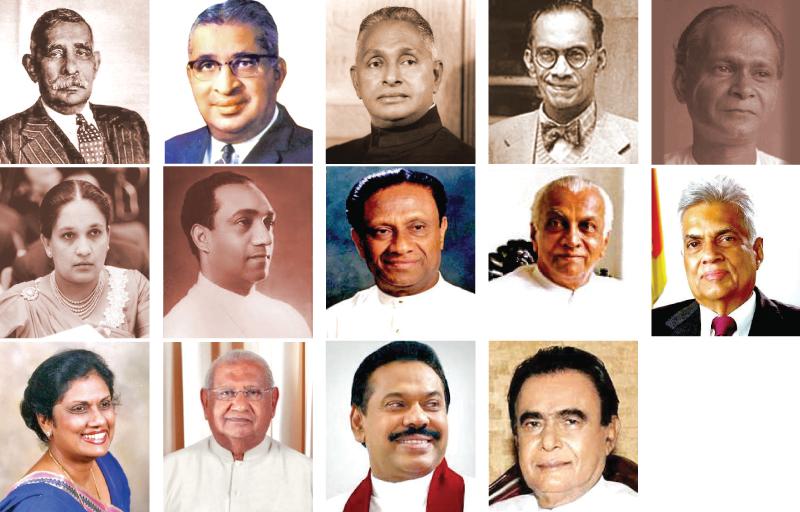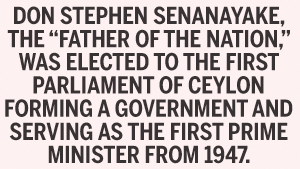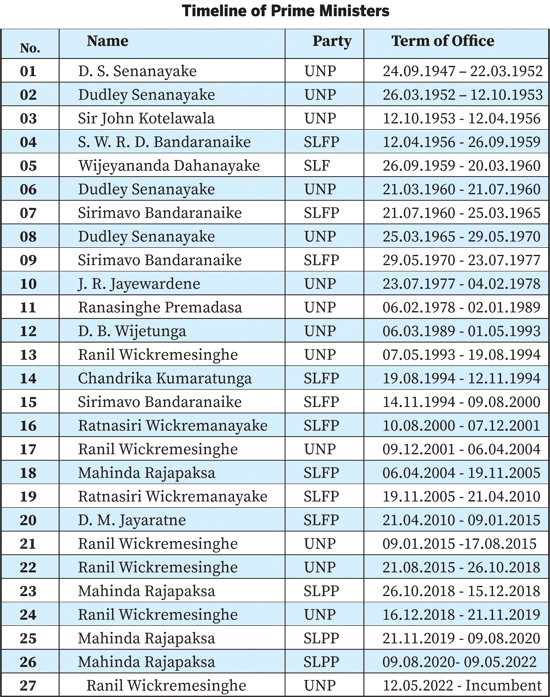
At a time, the cynosure of all eyes is on the chair of the Prime Minister, today, May 22, 2022, the island nation sail past the 50th anniversary of becoming a Democratic Socialist Republic and change of the country’s name from ‘Ceylon’ to ‘Sri Lanka.’ This article reflects on the times and lives of the Prime Ministers who have served the nation.
On May 12, 2022, one of the country’s political stalwarts, Ranil Wickremesinghe, 73, became the new Prime Minister of Sri Lanka. His appointment by President Gotabaya Rajapaksa comes at a very crucial juncture. Wickremesinghe, took oaths as the new Prime Minister following the resignation of Mahinda Rajapaksa on May 9, 2022.
Wickremesinghe, who is perceived as the experienced political leader who could command international cooperation, has been tasked with handling of the fragile economy and containing the civil unrest in Sri Lanka. It is indeed a herculean task for him, the only Member of Parliament from the United National Party (UNP) in the current Parliament.
Wickremesinghe has held key posts during his political career spanning four and a half decades and said to be the only politician to have sworn in as the Prime Minister of his country six times in the world politics (May 7, 1993, December 9, 2001, January 9, 2015, August 21, 2015, December 16, 2018 and May 12, 2022).
Chair of the Prime Minister
 The Prime Minister of Ceylon served as the Head of the Government from gaining independence on February 4, 1948 until May 22, 1972, when the country was named as the Free, Sovereign and Independent Republic of Sri Lanka. Since then, the position was known as the Prime Minister of Sri Lanka.
The Prime Minister of Ceylon served as the Head of the Government from gaining independence on February 4, 1948 until May 22, 1972, when the country was named as the Free, Sovereign and Independent Republic of Sri Lanka. Since then, the position was known as the Prime Minister of Sri Lanka.
The introduction of new Constitutional changes on February 4, 1978, saw the introduction of the position of the Executive President, resulting in the powers of the Prime Minister being reduced. The President became the Head of State and Chief Executive, and the Prime Minister became a weak Head of Government.
Of the fourteen Prime Ministers who have held the office since 1947, the incumbent Ranil Wickremesinghe has been sworn in a record 6 times. Dudley Senanayake was the youngest Prime Minister at 40 years 9 months and 7 days. The longest continuous term of 11 years and 27 days was served by Ranasinghe Premadasa.
The longest stint of premiership of 17 years 6 months and 24 days is credited to Sirimavo Bandaranaike. Amongst the political parties, the UNP produced eight of the Prime Ministers whilst the Sri Lanka Freedom Party (SLFP) produced six. Five of the Prime Ministers have gone on to become President of the country.
The list of Prime Ministers features combinations of ‘father and son’ (D. S. Senanayake and Dudley Senanayake), ‘ uncle and nephew’ (D. S. Senanayake and John Kotelawela, J. R. Jayewardene and Ranil Wickremesinghe), ‘cousins’ (Dudley Senanayake and John Kotelawela), ‘husband and wife’ (S. W. R. D. Bandaranaike and Sirimavo Bandaranaike)‘father, mother and daughter’ (S. W. R. D. Bandaranaike, Sirimavo Bandaranaike and Chandrika Kumaratunga).
Under the current Constitution, the Prime Minister is the leader of the Cabinet and also functions as a deputy to the President. In the event a President dies in office, the Prime Minister becomes the acting President until the Parliament convenes to elect a successor or new elections can be held to elect a new President.
Prime Ministers of Sri Lanka
Don Stephen Senanayake, the “Father of the Nation,” was elected to the first Parliament of Ceylon forming a Government and serving as the first Prime Minister from 1947. The country gained independence under his leadership on February 4, 1948. Earlier, he was elected unopposed to the Legislative Council of Ceylon from Negombo in 1924. Then, in 1931, he was elected to the State Council of Ceylon, where he served as the Minister of Agriculture and Lands. He died in an accident on March 22, 1952.
His eldest son, Dudley Shelton Senanayake was appointed as the second Prime Minister in 1952. Dudley Senanayake entered national politics in 1936 when he was elected to the State Council. He succeeded his father as Minister of Agriculture and Lands in 1946 and continued in this capacity in his father’s Cabinet from 1947 to 1952. He won the 1952 Parliamentary Elections and continued without a re-appointment until resigning in 1953.
Sir John Lionel Kotelawala took over as the third Prime Minister in 1953. He entered mainstream politics in 1931 having been elected to the State Council of Ceylon. He went on to serve as Minister of Communications and Works in the second Board of Ministers of Ceylon. Later, he became the Minister of Transport and Works in the first Cabinet. Sri Lanka joined the United Nations under his premiership on December 14, 1955.
Solomon West Ridgeway Dias Bandaranaike was the fourth Prime Minister, serving from 1956 until his assassination in 1959. He was the founder of the left-wing and the SLFP. His tenure saw the country’s first left-wing reforms. He entered local politics by joining the Ceylon National Congress, having been elected to the Colombo Municipal Council in 1926. He was elected to the State Council of Ceylon from Veyangoda for two terms between 1931 and 1947.
Bandaranaike served the second term as the Minister of Local Administration. He was elected to the House of Representatives in 1947 from Attanagalla. Bandaranaike also served as the Minister of Health and Local Government in Senanayake’s Cabinet. On September 25, 1959, Bandaranaike was shot at his house in Colombo and died the day after.
Wijayananda Dahanayake replaced him as the fifth Prime Minister. However, following disagreements, he was forced to dissolve the Parliament.
Dudley Senanayake returned to active politics in 1957.
His second term as Prime Minister commenced in March 1960, but his Government was defeated after one month, yet he continued until July 1960. Then, he served as the Leader of the Opposition from 1960 to 1964.
Following her husband’s assassination in 1959, Sirimavo Ratwatte Dias Bandaranaike entered politics, becoming Chairwoman of the SLFP. She led her party to victory and became the world’s first female Prime Minister on July 21, 1960. She played a pivotal role abroad as a negotiator and a leader among the Non-Aligned Nations. However, her tenure was marked by inadequate economic development at the national level.
Dudley Senanayake was elected Prime Minister in 1965, when his party formed a Government with the help of six other parties. He served until 1970 and initiated planning for the most ambitious project of the Mahaweli Development program. The agriculture sector was given high priority during his term of office. Following the election defeat in 1970, Senanayake remained a Member of Parliament and the partly leader until his death on April 13, 1973.
Sirimavo Bandaranaike as the Prime Minister oversaw the drafting of a new Constitution. She declared the country a republic on May 22, 1972. She nationalised many companies and imposed restrictions on several imports and this led to the downfall of the country’s economy, and she was defeated in the 1977 Parliamentary Elections. Failing to win the office of President in 1988, she served as Leader of the Opposition from 1989 to 1994.
Junius Richard Jayewardene served as Prime Minister from 1977 to 1978 and as the First Executive President of Sri Lanka from 1978 to 1989. He was a leader of the nationalist movement in Ceylon who served in a variety of Cabinet positions in the decades following independence.
 A longtime member of the UNP, he led it to a landslide victory in 1977. A controversial figure in the history of Sri Lanka, his open economic system introduced in 1978 brought the country out of the economic turmoil Sri Lanka was facing as the result of the preceding closed economic policies.
A longtime member of the UNP, he led it to a landslide victory in 1977. A controversial figure in the history of Sri Lanka, his open economic system introduced in 1978 brought the country out of the economic turmoil Sri Lanka was facing as the result of the preceding closed economic policies.
Jayewardene also launched large scale infrastructure development projects as well as an extensive housing development program. The Accelerated Mahaweli Program built new reservoirs and large hydropower projects such as the Kotmale, Victoria, Randenigala, Rantembe and Ulhitiya. He appointed Ranasinghe Premadasa as the Prime Minister after the Constitutional changes with powers of the position reduced significantly.
President Premadasa appointed Dingiri Banda Wijetunga as the Prime Minister, he resigned but was reappointed two days later. Ranil Wickremesinghe was appointed as the Prime Minister when Wijetunge was elevated as the President of Sri Lanka, following the assassination of President Premadasa on May 1, 1993. Ranil Wickremesinghe was credited for pushing the country through an impressive economic transformation, backed by the business community during his tenure of 1993-1994.
Chandrika Bandaranaike Kumarathunga served as the Prime Minister, until the 1994 Presidential Elections and became the President. She appointed Sirimavo Bandaranaike as the Prime Minister. Ratnasiri Wickremanayake assumed duties as the Prime Minister following the resignation of Sirimavo Bandaranaike in 2000.
Ranil Wickremesinghe’s term of office ended early when President Kumaratunga dismissed his Government in 2004. As the Prime Minister, Wickremesinghe mustered the support of the international community towards development and same led to the 2003 Tokyo Donor Conference. He also proposed the creation of the “Western Region Megapolis” project.
Wickremesinghe’s foreign policy pushed the country to closer relations with the West. In 2002, he met with the President of the US, the Prime Ministers of the UK, Japan and India, focused on resolving the ethnic problem in Sri Lanka. The Oslo Declaration, “both parties had decided to explore a political solution founded on internal self-determination based on a federal structure within a united Sri Lanka,” was one of his significant milestones.
Mahinda Rajapaksa was appointed as the Prime Minister in 2004 and he won the 2005 Presidential Elections and assumed duties of the President. Ratnasiri Wickremanayake replaced him as the Prime Minister. A series of mine blasts blamed on the LTTE claimed the lives of many off-duty servicemen and civilians, pushing the country back to the brink of civil war.
The closure of the Mavil Aru reservoir supplying water to 15,000 people in Government-controlled areas on July 21, 2006, resulted in the Sri Lankan military launching an offensive against the LTTE, bringing the entire reservoir under Government control.
Successful military engagements resulted the LTTE being driven out of the entire Eastern and Northern Provinces. The Sri Lankan Government declared total victory on May 18 and President Mahinda Rajapaksa delivered a victory address to the Parliament on May 19, 2009, declaring that Sri Lanka was liberated from terrorism.
After the 2010 Parliamentary Elections, President Mahinda Rajapaksa appointed Dissanayake Mudiyanselage Jayaratne as the Prime Minister. Ranil Wickremesinghe was appointed as Prime Minister by President Maithripala Sirisena after winning the 2015 Presidential Elections.
Wickremesinghe proposed major economic reforms and a knowledge based social market economy built on social justice principles. His foreign policy was aimed at re-balancing relations with India and the West.
Wickremesinghe was re-elected in the 2015 Parliamentary Elections and continued till the 2018 Sri Lankan Constitutional crisis.
In October 2018, President Maithripala Sirisena appointed Mahinda Rajapaksa as Prime Minister and informed that Ranil Wickremesinghe had been removed from office. Following rulings by the Supreme Court and the Appeal Court, Wickremesinghe was re-instated as the Prime Minister in December 2018.
After the 2019 Presidential Elections, President Gotabaya Rajapaksa appointed Mahinda Rajapaksa and he was re-appointed following the 2020 Parliamentary Elections.
Most of his tenure was plagued with major economic and political crises and Mahinda Rajapaksa was forced to resign amid the 2022 Sri Lankan political crisis and protests.
Portfolio of the Prime Minister
Ranil Wickremesinghe was born on March 24, 1949 in Colombo as the second son of Esmond Wickremesinghe and Nalini Wickremesinghe nee Wijewardene. He graduated from the University of Ceylon and qualified as an Advocate from the Ceylon Law College in 1972.
Wickremesinghe had his entire education at Royal College, Colombo. He entered the Faculty of Law of the University of Colombo and became an Attorney-at-Law following the changes to the legal profession in 1973.
He married Maithree, an academic and Professor of English in 1994 and they have kept their private life out of politics. Wickremesinghe was conferred with an Honorary Doctorate from the Deakin University in Australia on February 14, 2017, for his significant contributions towards reforms in economy, education and human rights.
He entered active politics in the mid-1970s with the UNP as the chief organiser of the Kelaniya Electorate and was later appointed as the chief organiser of the Biyagama Electorate, which he won in the 1977 Parliamentary Elections.
In 1977, he became the Deputy Minister of Foreign Affairs and initiated the Sri Lanka National Guard and the National Youth Services Council. He was soon elevated as the Minister of Youth Affairs and Employment and became the youngest Cabinet Minister.
In 1989, he was made the Minister of Industry, Science and Technology under which he initiated industrial reforms and established the Biyagama Special Economic Zone. He became the leader of the UNP in 1994.
At the 1999 Presidential Elections, Wickremesinghe lost to the incumbent President Kumaratunga by 709,409 votes, after a tense election campaign. At the 2005 Presidential Elections, Wickremesinghe was defeated by Mahinda Rajapaksa, narrowly by 180,786 votes.
At the 2015 Parliamentary Elections, Wickremesinghe became the Prime Minister, recording a mammoth 500,556 preferential votes. The 2020 Parliamentary Elections saw Wickremesinghe’s UNP failing to win a single seat. Still, he re-entered the Parliament through the UNP’s solitary National List seat and was sworn in as a Member of Parliament on June 23, 2021.
